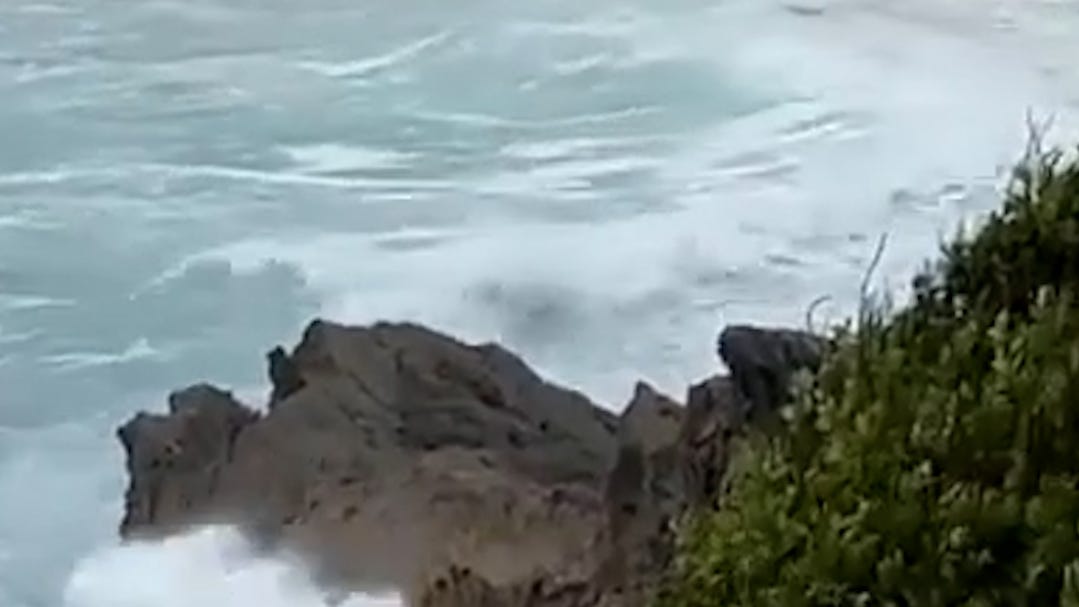
Hurricane Ernesto hits Bermuda, bringing danger to US beaches
Hurricane Ernesto hit Bermuda as a hurricane. It can send life-threatening surf and rip currents along the East Coast of the United States
Millions of Americans flocked to beaches just days before schools opened as swells from Hurricane Ernesto re-strengthened into a hurricane on Sunday, posing a grave danger to swimmers along much of the Atlantic coast.
The National Hurricane Center said “life-threatening surf and disruptive current conditions will continue” for the next few days, with lifeguards advising beachgoers to stay out of the water. National Weather Service offices Maine to do FloridaWarning of dangerous rip currents.
Ernesto, centered about 520 miles south of Halifax, Canada, strengthened just above the threshold for a Category 1 hurricane as its maximum sustained winds increased from 70 to 75 mph. The storm was moving north-northeast at 17 mph. Ernesto is forecast to pick up some speed and turn east-northeast in the coming days.
Ernesto has been blamed for at least three deaths after two people drowned on South Carolina’s Hilton Head Island on Friday and a swimmer was found unresponsive in the waters off Surf City, North Carolina on Saturday. The Hurricane Center said dangerous surf and rip currents are possible in the Bahamas, Bermuda and Atlantic Canada over the next few days.
‘Don’t become a statistic’: Hurricane Ernesto brings rip current danger to millions of people
Developments:
∎ The New York City Parks and Recreation Department banned swimming at Queens and Brooklyn beaches on Sunday.
∎ The center of weak Ernesto forms near southeastern Newfoundland, Canada late Monday into Tuesday morning.
∎ In New Jersey, emergency management officials discouraged beachgoers from entering the water when lifeguards were not on duty: “Keep your feet in the sand until the lifeguards stop!” Dozens of rescues have been reported in recent days.
A third death was caused by rip currents created by Ernesto along the Atlantic coast, the National Weather Service said.
Two rescue swimmers from the Surf City Fire Department in North Carolina responded to a swimmer’s call at 2:46 p.m. Saturday, the city said in a news release. Rescue swimmers found Sean Davis, 41, of Hampstead, North Carolina, unresponsive in the water. Lifesaving measures were taken on the beach, but Davis did not survive, the city said.
Elsewhere on the North Carolina coast Saturday, 23 rip current rescues were reported at Wrightsville Beach, five at Carolina Beach and one at Gure Beach, the weather service said.
− Tina Voyles Bulwer
In the North Carolina Outer Banks town of Rodante, Chicamacomico Banks Fire & Rescue released photos of the mangled remains of a waterfront home washed into the Atlantic Ocean. The agency said in a string that many houses are at risk of collapse from Ernesto. Social media posts. The agency warned that debris in the water increases the risk to swimmers.
“High rip current risk in rotande, waves and salvo today and tomorrow,” the agency warned. “Entering the sea is not recommended.”
Rip currents are short, strong currents that move quickly away from shore. Normally, they move between 1 and 2 feet per second, but they can move faster than any Olympic swimmer at 8 feet per second, or 5.5 mph. They are usually no more than 80 feet wide.
Normally, when waves hit the beach, the water flows back into the sea in a uniform fashion. But low-lying areas on the sea floor, near breakwaters or sandbars, can disrupt uniform water circulation. Thus, water flows through an area A powerful tearing current outwards. If you’re caught in the current, relax. Rip current pulls you out, not under. Float or tread water until you escape or are rescued.
Officials in Bermuda were counting their blessings after Ernesto caused less damage than expected before heading north.
Forecasts indicated that Ernesto could reach the British Isles as a Category 3 hurricane with damaging winds of at least 111 mph after two days of wandering in the warm west-Atlantic. But the storm weakened slightly, becoming a Category 1 hurricane with winds of 89 mph Saturday morning.
Ernesto still left three-quarters of Bermuda without power as it uprooted trees and flooded streets, but no major injuries or damage were reported. Most of the archipelago’s 64,000 residents appear to have followed government orders to stay indoors during the height of the storm.
“There have been no calls for service for any major incidents or any property damage, and the calls we’ve received in the last six hours have been primarily flood,” reports Risk Management Officer Lyndon Rayner. said in a Saturday update.
Ernesto, the fifth named storm and third hurricane of the current season, has yet to reach its peak and is widely expected to be slightly more active than usual. The season runs from June 1 to November 30 and usually reaches its peak from late August to late September.
The latest forecast from the National Oceanic and Atmospheric Administration calls for 17-24 named storms and 8-13 hurricanes. The forecast calls for 4 to 7 storms to reach major status, meaning a Category 3 hurricane with winds of at least 111 mph. Annual averages are 14.4 named storms, 7.2 hurricanes and 3.2 major.
Hurricane Beryl heralded the season’s most damaging storms when it became the first Category 5 hurricane on record on July 1, fueled by unusually warm waters in the Atlantic. Dumping heavy rains, leading to widespread flooding, rather than blowing away infrastructure with strong winds.
Contributed by: Mike Snyder and Eduardo Cuevas